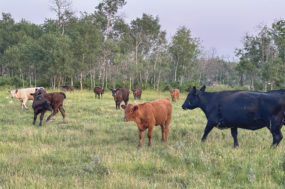While it is February, and much of the West is still calving, bull selection is right around the corner. Choosing the correct bulls to use on your herd requires many decisions about growth and performance; however, one consideration for Western cattle producers is pulmonary arterial pressure, or PAP scores. PAP scores were developed at Colorado State University in response to high incidence of high mountain or brisket disease. As the name implies, high mountain disease most commonly occurs at high elevations and is due to the low atmospheric pressure in these climates affecting the rate of oxygen intake.
Cattle are more susceptible than other species to this change in atmospheric pressure due to their small lung capacity relative to their size. The low-oxygen environment leads to pulmonary shunting, essentially blood skipping the oxygenation phase in the lungs. Due to a low oxygen concentration in the blood, or hypoxia, the heart works harder to pump and circulate blood through the body, eventually leading to the heart thickening and development of congestive heart failure. Cattle with brisket disease are in late stages of heart failure where we see fluid pooling in the brisket area. Luckily for most of the U.S., high mountain disease most commonly affects cattle above 6,500 feet elevation, but can be devastating in a herd experiencing the problem.
PAP testing is performed by a veterinarian, who will insert a catheter into the heart and measure the pressure using a pressure transducer. PAP scores can change as animals age, due to physiological changes as the animal grows. Animals 16 months or older and below a 41/mmHg (millimeters of mercury) PAP score are considered at low risk of developing high mountain disease. The only fix for high PAP scores in cattle is to take those animals to a lower elevation where their circulatory system is not stressed. PAP scores cannot be reliably measured below 5,000 feet, and animals must have an acclimation time of 60 days at that elevation, otherwise the score will be inaccurate. Low PAP scores are not a guarantee that an animal will not develop high mountain disease, but they are a great place to start and something that can be selected for genetically.
There is emerging evidence that cattle that are genetically susceptible to high mountain disease may also be at higher risk for developing heart failure as fat cattle in feedlots. Many breed associations are starting to report EPD scores for PAP, with 0 representing no expected change, negative values representing an expected lowering of PAP (desirable) and positive values representing an increase of PAP (not desirable).
This spring, when you are selecting bulls to breed cows at high elevation or selecting bulls for use as terminal sires for calves destined for a feedlot, consider using PAP score as a metric of selection.








